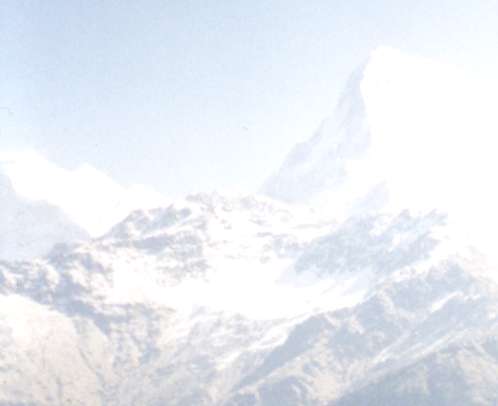 |
 |
|
I've decided to trek along the edge of the Annapurna mountain range, following the deepest valley in the world, an ancient trading route for salt from Tibet with grain from Nepal. My final destination is Muktinath, a holy pilgrimage point for a miracle of nature that occurs there. In a temple there, earth, fire and water mix. Packing and re-packing at a guest house in Pokhara, waiting for the sun to fully rise to dry out my jeans. Out by 9a.m., I grab a cab to the bus station with my "rations", 10 small packs of biscuits. The bus for Nayapul is leaving. I end up sharing a Toyota Corolla taxi with a Nepalese driver, two Nepalis and an Indian. The paved road fits one vehicle, but inexplicably serves as a two-way road. Passing slow-moving vehicles is accomplished by making full use of the rocky dirt shoulder, often coming precipitously close to a large drop off. We pass stepped hillsides and small villages, and stop at one point to buy yellow berries that a child at the side of the road has collected. They drop me off in Nayapul, saying the trail I seek leads off north into the mountains. The sound of the cab motor dies off as they round a distant corner. A young Nepalese man, looking frayed at the edges and wearing a baseball cap and baggy jeans, singles me out. His schedule molds to match mine; he lives near Syauli Bazar, where I hope to stop for lunch, and he wants to check up on some British women he left the previous day in Ghandrung, my destination for the day. An old woman we meet on the rocky dirt trail chides my new friend for his Nepalese New Years' revelry of the previous night. It's day one of the year 2055 on the Nepalese calendar. We cross a rickety wooden bridge and enter Birethanti, at 3,444 feet, the base of a valley.
I show my trekking permit at the police checkpoint, which sits on the border of the Annapurna Conservation Area. The man who checks my permit warns me mysteriously that the young man I have taken up with is not to be trusted. Trek.
The scenery is breathtaking, farms on green stepped hillsides that stretch skywards towards jagged snow-covered peaks. Nepalese herd long lines of donkeys whose ankle bells jingle along the rock-strewn mountain trails. The donkeys carry loads of food and drink to the villages that dot the trails but are off the "paved road grid". The goods they carry rise in price in direct proportion to the distance they are carried; the more remote the village, the higher the price. Daal bhat, a rice/vegetable/potato/lentil all-you-can-eat meal that forms the staple of the Nepalese diet, can cost anywhere from about 50 Nepalese rupees up to 120 rupees and beyond. At 60 rupees to the dollar, even the latter price is a deal. Most Nepalis subsist on two meals of daal bhat a day, one in the middle of the morning and the other in the early evening. After asking my trekking companion's name at least three times and finally writing it down, I have it: Bihim Bahadur. Bihim's stomach is bothering him and he stops often to rest, chatting amiably with his many acquaintances in the rural villages we pass through and flirting with Nepalese women, whom he calls "sister". Four Buddhists pass by dressed brightly in yellow shirts and carrying rainbow umbrellas to shade themselves from the sun. We stop for tea in a shop run by a strong, beautiful Nepalese woman and her mother. Nepalese have a strength of character that shows in their faces. Most are physically very strong as well, carrying loads of up to 130 pounds up and down these steep mountain trails. They have even been known to carry injured people over long distances to safety. We pass an eco-environmental one-room school house, where a class of Nepalese schoolchildren are just getting out. I move on, desiring to reach Ghandrung before nightfall. Kids are playing volleyball. At the end of the valley we follow, the Annapurnas are visible, their peaks obscured by a gathering storm that brings gusts of wind and dust down the valley. We reach Ghandrung at sunset and stay at the Annapurna Lodge. A group of Australian teenagers on an organized trip are camped out in a dozen tents nearby. Their porters struggle to set up the mess tent in the wind and make a joyous, comical game of it. What a view of the Annapurnas! The route to Annapurna Base Camp in the Annapurna Sanctuary is through a narrow valley that cuts into the wall of the Annapurnas, which reach for the sky with rugged, snow-covered peaks that transport the senses to an ethereal realm. |

